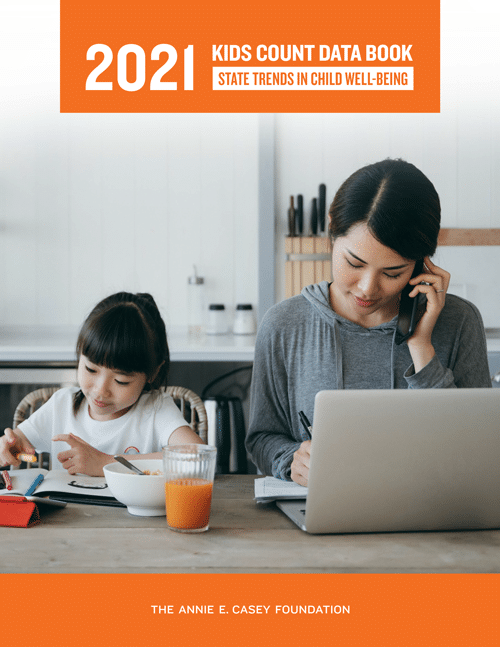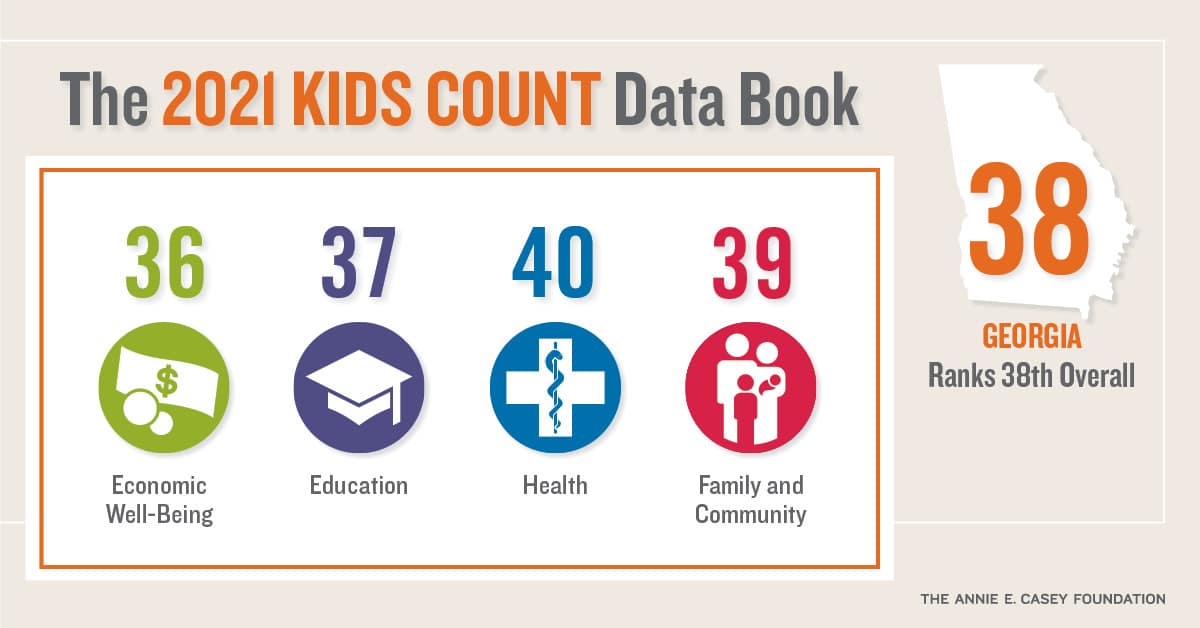Georgia Ranks 38th in the Nation for Child and Family Well-Being
Print This PostGeorgia improves on some economic indicators, loses ground or stalls on education indicators
Georgia again ranks 38th in the nation in child and family well-being, according to the 2021 KIDS COUNT® Data Book, released today by The Annie E. Casey Foundation. The annual report identifies areas where Georgia’s children face struggles and measures where they’re making progress across four domains: economic well-being, education, family and community, and health.
The data in this year’s report are from 2019, so Georgia’s ranking does not reflect the unique challenges families have faced throughout the COVID-19 pandemic to remain healthy, to put food on the table, and for children to succeed in school. While Georgia’s overall rank remains unchanged from last year, some of the data points within each of the domains have changed. Georgia improved on some economic indicators, but lost ground or stalled on education indicators.
Economic Well-Being
The data reveal that prior to the pandemic Georgia’s child poverty rate had dropped to 19%, down from a high of 27% in 2012 and 2013. The percentage of children living in households where no parent had full-time employment also decreased to 26% in 2019 from a high of 35% in 2011.
However, data collected this year from the Census Bureau’s Household Pulse Survey, which is a separate dataset from the indicators used to make the annual ranking, show that Georgia residents often struggled with financial security during the pandemic. As of March 2021, almost 1 in 5 Georgians had little or no confidence in their ability to make their next rent or mortgage payment on time, while 14% of Georgia households with children reported not having enough to eat “sometimes or often” in the past week.
Education
Prior to the pandemic, Georgia’s recent gains in educational attainment were slowing down, with 69% of eighth-grade students scoring below proficient in math, the same as last year, and 68% of fourth-grade students scoring below proficient in reading, three percentage points worse than the prior year.
“Issues that underlie reading proficiency are systemic, entrenched, and they intersect, which is why we continue to mobilize and support community, business leadership, and other partners to take a holistic approach rather than focusing solely on the school system,” said Get Georgia Reading—Campaign for Grade-Level Reading Director Arianne Weldon. “This requires a long-term effort. We know and understand that there will be ebbs and flows, but as we dig ourselves out of the hole this pandemic has caused for our most vulnerable kids, it’s our best shot at ensuring access to a higher quality of life in adulthood for them.”
The Household Pulse Survey also showed that the lockdown to limit the virus’s spread created barriers to educational progress for Georgia students and educators. According to surveys conducted in March, 17% of students did not usually or always have internet and access to a computer or digital device for remote learning—the primary mode of education this past school year.
“Over the past decade, Georgia has strategically invested in and expanded upon a strong foundation in its early learning system and a focus on grade-level reading,” said Georgia Partnership for Excellence in Education President Dana Rickman. “We steadily improved reading outcomes over several years. We should celebrate this achievement, while also remaining clear-eyed about more work to be done to ensure that all young children in Georgia, particularly those living in poverty and rural communities, have access to high-quality early learning programs and ongoing support through the K-12 system. Looking ahead to the next decade, Georgia must continue to invest in the tools, shared data platforms, and cross-agency collaboration to ensure that the gains made by children participating in high-quality early learning programs don’t fade or disappear completely.”
Health
Georgia’s rate of low birthweight babies plateaued pre-pandemic after increasing for the past several years. Low birthweight births are defined as infants weighing less than 5.5 pounds at birth, with low birthweight being the single greatest predictor of infant mortality within the first year of life.
“While this is encouraging news, there’s still a long way to go to foster healthier outcomes for babies in our state,” said Healthy Mothers, Healthy Babies Coalition of Georgia Executive Director Ky Lindberg. “Preterm labor, chronic health conditions, fetal growth restrictions, and a myriad of factors contribute to low birthweight. We must increase access to, and participation in, high-quality prenatal care and education for all birth givers. Given the limited access to prenatal care across rural Georgia and the disproportionate quality of care women of color receive, we can increase access to vital prenatal care and education through collaborative cross-sector partnerships and by disseminating evidence-based programs.”
The data also showed that 7% of Georgia’s children did not have health insurance as of 2019, down from a high of 10% in 2010, but worse than the national average of 6%. During the pandemic, 14% of Georgia adults living in households with children reported not having health insurance, at a time when access to health care was critical. The pandemic also affected mental health, with 20% of Georgia adults in households with children reporting feeling down, depressed, or hopeless.
Family and Community
The rate of children living in high poverty areas prior to the pandemic fell to 9%, down from a high of 17% in 2011 through 2015. While the child poverty rate speaks to individual children and families, the rate of children living in high poverty areas speaks to a community—and to the resources and opportunities available to children there.
Georgia’s teen birth rate (ages 15 – 19) fell again in 2019 to 20 per 1,000, down from 41 per 1,000 in 2010. Delaying a first birth until after the teen years makes a teenager much more likely to finish high school on time, which can have long-term implications for postsecondary education, job opportunities, military enrollment, and future poverty status.
“Georgia was moving in the right direction in some areas prior to the pandemic, though with clear room to improve,” said Georgia Family Connection Partnership Executive Director Gaye Smith. “The Household Pulse Survey, however, clearly shows that the pandemic posed serious struggles for Georgia’s families and communities. Investing in our people and seizing every opportunity that materializes from this past year that has been unlike any in our lifetimes will have a profound positive effect on our communities long after this pandemic is behind us.”
Go to the 2021 KIDS COUNT® Data Book.
Journalists interested in creating maps, graphs, and rankings in stories about the Data Book can use the KIDS COUNT® Data Center at datacenter.kidscount.org.
Contact:
Bill Valladares
GaFCP Communications Director
404-739-0043
william@gafcp.org
Follow us on Twitter: @gafcpnews
Connect with us on Facebook.
Georgia Family Connection Partnership (GaFCP) is a public-private partnership created by the State of Georgia and investors from the private sector to assist communities in addressing the serious challenges facing children and families. GaFCP also serves as a resource to state agencies across Georgia that work to improve the conditions of children and families. Georgia KIDS COUNT provides policymakers and citizens with current data they need to make informed decisions regarding priorities, services, and resources that impact Georgia’s children, youth, families, and communities. Georgia KIDS COUNT is funded, in part, through a grant from The Annie E. Casey Foundation, a private charitable organization dedicated to helping build better futures for disadvantaged children in the United States. For more information, visit gafcp.org.
The Annie E. Casey Foundation creates a brighter future for the nation’s children by developing solutions to strengthen families, build paths to economic opportunity and transform struggling communities into safer and healthier places to live, work, and grow. KIDS COUNT® is a registered trademark of The Annie E. Casey Foundation.


